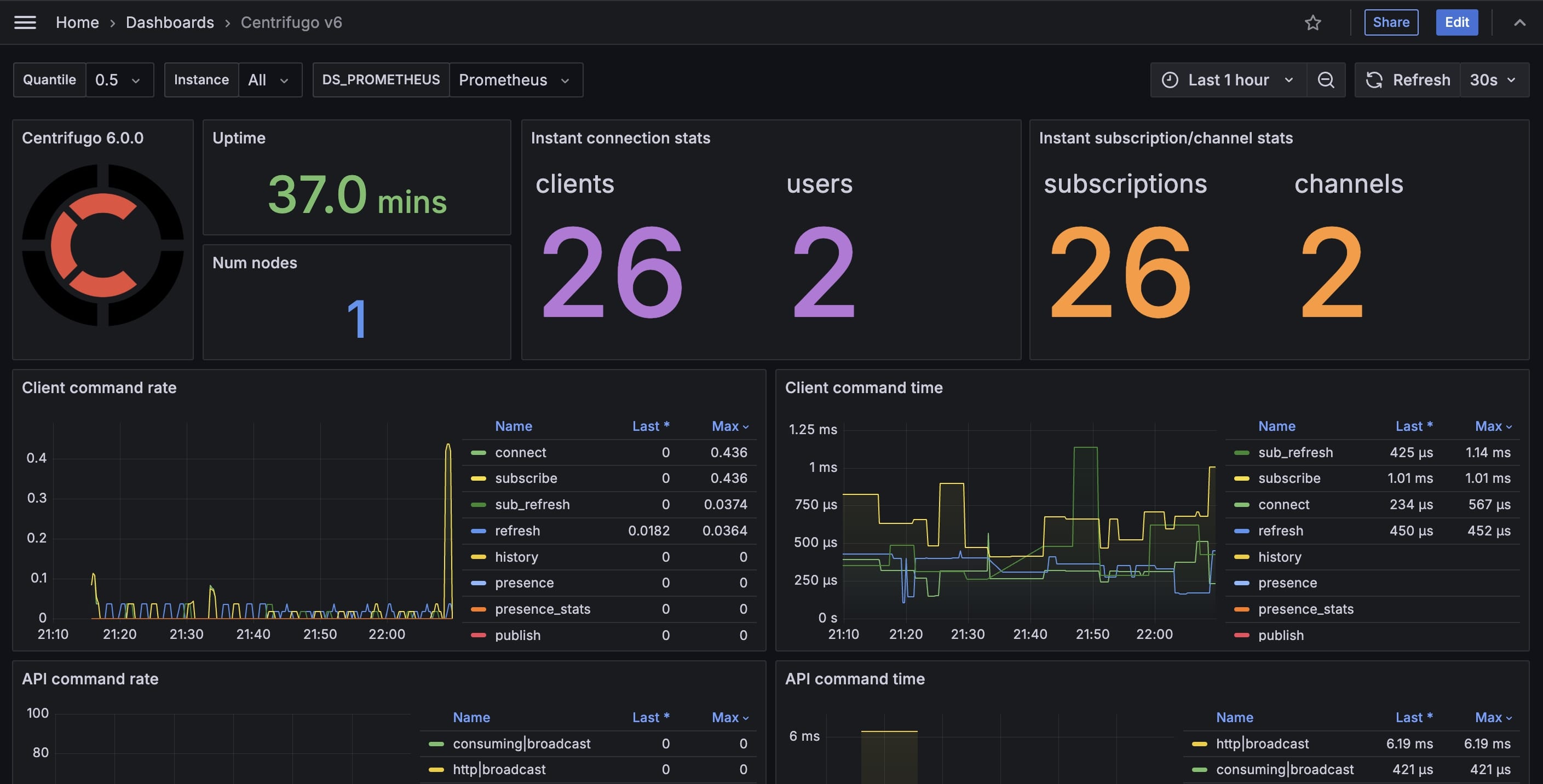Appendix #3: Adding Prometheus and Grafana
Let's move a bit further and show how to add Centrifugo monitoring to our messenger application. We will use Prometheus and Grafana for this.
Prometheus
Prometheus is a popular monitoring system and time series database. It collects metrics from monitored targets by scraping metrics HTTP endpoints. Centrifugo has built-in support for Prometheus metrics.
The first step would be adding Prometheus service to our docker-compose.yml file. We will use the official Prometheus Docker image. Here is how the service definition looks like:
prometheus:
image: prom/prometheus:v3.0.1
volumes:
- ./prometheus/prometheus.yml:/etc/prometheus/prometheus.yml
command:
- '--config.file=/etc/prometheus/prometheus.yml'
ports:
- 9090:9090
We also need to create a prometheus.yml file in the root of our project. Here is how it looks like:
global:
scrape_interval: 5s
scrape_configs:
- job_name: 'centrifugo'
static_configs:
- targets: ['centrifugo:8000']
This configuration tells Prometheus to scrape metrics from Centrifugo container every 5 seconds.
In Centrifugo configuration we also need to enable Prometheus metrics endpoint. Here is how it looks like:
{
...
"prometheus": {
"enabled": true
}
}
Now once you start the app with docker compose up you can open Prometheus UI at http://localhost:9090 and see Centrifugo metrics.
Grafana
Many users prefer to use Grafana for visualizing metrics collected by Prometheus. Let's add Grafana service to our docker-compose.yml file. We will use the official Grafana Docker image. Here is how the service definition looks like:
grafana:
image: grafana/grafana-oss:11.4.0
depends_on:
- prometheus
# Expose Grafana on host port 3000
ports:
- "3000:3000"
environment:
- GF_SECURITY_ADMIN_USER=admin
- GF_SECURITY_ADMIN_PASSWORD=admin
volumes:
# Mount local provisioning directory to automatically configure Prometheus as a datasource
- ./grafana/provisioning:/etc/grafana/provisioning
- grafana-data:/var/lib/grafana
We also need to create a datasource.yml file in the grafana/provisioning/datasources directory. Here is how it looks like:
apiVersion: 1
datasources:
- name: Prometheus
type: prometheus
url: http://prometheus:9090
access: proxy
isDefault: true
This configuration tells Grafana to use Prometheus as a default datasource.
Now once you start the app with docker compose up you can open Grafana UI at http://localhost:3000 and login with admin/admin credentials.
Then you can simply import Centrifugo official Grafana dashboard. To import a dashboard in Grafana go to http://localhost:3000/dashboards, click on the New button in the top-right corner and select Import. Then you need to put the dashboard ID (13039) into the form and click Load. After that select Prometheus as a datasource for the dashboard and click Import. And enjoy visualized metrics:

That's it! Now you have Centrifugo metrics visualized in the application. You can even use Grafana alerting feature to notify you over tons of supported communication channels (Slack, email, and so on) in case of metric changes.
We did it again
Here we showed how to add Prometheus and Grafana to our messenger application to monitor Centrifugo metrics.
In real-world applications the way of Prometheus and Grafana setup can be different, but the core idea is the same. For example, in Kubernetes you can use Helm charts to deploy Prometheus and Grafana stack and use k8s service discovery to find Centrifugo instances.
For the convenience we've included Prometheus and Grafana support to the source code of our tutorial, so it works out of the box, but you need to import Grafana dashboard manually in a way described above.